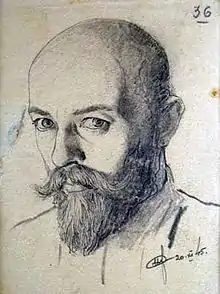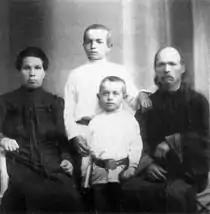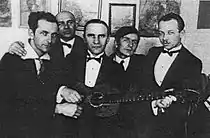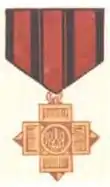Nil Khasevych
Nil Antonovych Khasevych (Ukrainian: Ніл Антонович Хасе́вич, November 25, 1905, in Dyuksyn village, Kostopil Raion, Rivne Oblast — March 4, 1952, in Suhivtsi (Rivne region) village, Rivne Raion, Rivne Oblast) is a Ukrainian painter, graphic artist, active public and political figure, member of the OUN and the UHVR. He was also a knight of the Silver Cross of Merit and the Medal "For the fight in especially difficult circumstances".

His pseudonyms are Bey-Zot, Levko, Rybalka, 333, Staryi, and Dzhmil.
Biography
Childhood and youth

Nil Khasevych was born November 25 (November 12 Old Style) 1905 in the village Dyuksyn in Volhynia, now Kostopil Raion, Rivne Oblast, Ukraine, in a family of Psalomnyk Anton Ivanovych Khasevych and his wife Theodotia Oleksiivna. The village, according to the old administrative divisions, was Rivne district, Volhynian Governorate, Russian Empire. His brothers Anatoly and Fedir also become priests. Nil also studied at seminary.
Besides his talent for drawing, Khasevych also had a good voice.
In 1918, returning from Rivne, at the Derazhniansky railway crossing, he and his mother fell under a train. His mother died, and he lost a leg. As Neil could cut a variety of wood crafts, he had fashioned his own prosthetic leg.
Education and creativity

After treatment, he attended a workshop of Vasyl Len in Rivne. In 1925, he took an external exam and received a certificate of the Rivne Gymnasium. From 1925 to 1926, he worked as an assistant iconographer. With the money received as compensation for the accident, he used it to study at the Warsaw Academy of Fine Arts. The young man graduated from the graphics department, he studied painting with Professors Miłosz Kotarbiński and Mieczysław Kotarbiński, and graphics with Professor Władysław Skoczylas.
In Warsaw, he then worked with a small circle of Ukrainian artists and students in the Academy, who founded the Society Calm (circle), which included N. Khasevych, P. Andrusiy, V. Vaskivskyy, S. Drychyk, V. Zvarych, Petro Holodny, V. Havryliuk and Petro Mehyk. From memories of the last about his countryman:
In 1930 he belonged to the student union Zaporizhzhya. Defending a diploma work on the theme Saint Volodymyr, in 1935, Nil received a diploma of higher art education with the right of teaching in secondary schools. With the beginning of World War II he returned to his village. But even in 1931 his painting Laundry was awarded with the Vatican prize, and the next year, his portrait of Hetman Ivan Mazepa won the Warsaw Academy diploma.
Reflecting on the specifics of art, Nil Khasevych made a record on February 24, 1933:
To study this language, Neal Hasevych copied by hand with quill pen the Peresopnytsia Gospel. In the process he mastered the Cyrillic font.
Gradually moving from oil painting to graphics prints, he begins to engage engravings, and woodcutting (derevorizamy). In the early 1930s, Neil Hasevych exhibited his work in art salons of Lviv, Prague, Berlin, Chicago, Los Angeles. In 1937, he got a third cash prize at the International Exhibition of Engravings on a wood engraving in Warsaw. For two years, he printed an art album called Book marks of Nil Khasevych. This year, in the American city of Philadelphia, his art album, Ex libris of Nil Khasevych, was released. Nil collaborated with the Ukrainian magazine The Way and Volyn word. The artist tirelessly polished professional skills. His portraits of Prince Volodymyr the Great, bookplate of the president of UNR in exile Andriy Livytskyi, and the series of works in the anthology Woodcuts was highly appreciated by experts. He is compared to Ivan Trush, Heorhiy Narbut, and Vasyl Krychevsky.
 Volhynia. Canvas, oil. 1920th
Volhynia. Canvas, oil. 1920th Laundry. Canvas, oil. 1920th
Laundry. Canvas, oil. 1920th Initial "E". Woodcut. 1930th
Initial "E". Woodcut. 1930th Portrait. Woodcut. 1930th
Portrait. Woodcut. 1930th
Activity in the OUN

Khasevych was a successful artist and could easily live with the Crosses of Merit. Nil Khasevych was an active public and political figure, and a member of the Volhynia Ukrainian association (VUO) from 1935. He was a delegate to the Regional Congress of the VUO in 1935 in Lutsk. He was personally acquainted with Stepan Bandera and other Ukrainian leaders of the national movement. He was a member of the central and regional OUN leadership, and later, he joined the Ukrainian Supreme Liberation Council (UHVR). But the impending world war and the fate put him a choice. Along with the work, he is engaged in social and political activities: he took part in the Volhynia Ukrainian association, and later joined the OUN. Since April 1943, when groups of the UPA were formed in mass, he joined the underground work. He was elected to the central and regional leadership of the OUN.
From that time, he began a nomadic life. He worked in the Kriivka, and constantly changed his location because of the constant danger. He was known by the pseudonyms Bay-Zot, Levko, Rybalka, 333, Stary, and Dzhmil. Nil Antonovych was a talented propagandist who led an insurgency printing house. He also worked as an artist and editor, preparing illustrations for satirical magazines of the UPA "Ukrainian pepper" and "Horseradish", designed the pappus and leaflets for underground publication, and released an album of caricatures. He also worked on projects of flags, seals, forms for insurgents. During 1943 — 1944, he led a political-propagandist unit of the UP "North" group, commanded by Klym Savur (real name Dmytro Klyachkivskyy). After the death of his friend and leader, Khasevych remained on combat post for another seven years. His portfolio of the war and post-war era — 150 woodcuts, which was issued overseas in albums as "Volhynia in the fight" and "Graphics in UPA bunkers" during 1950 — 1952.
In 1941, he became a member of the Labor Union of Lviv, Ukrainian Fine Arts and worked with the Rivne Magazine "Volhynia" with Ulas Samchuk. In Nazi-occupied Lviv in 1942 — 1943, he held an exhibition of Ukrainian artists in which Nil Khasevych exhibited the work of patriotic themes, including "Sleep, guys, sleep".
In June 1948, the Ukrainian Supreme Liberation Council (UHVR) introduced awards for illegals, which earned them with a personal courage. In particular, "Zot" created sketches of the Cross of Merit and Cross of Combat Merit and medal "For the fight in especially difficult circumstances." Subsequently, the author was awarded the Silver Cross of Merit and Medal and elected to UHVR from Ukrainian intelligentsia. Few know about who he really was, what he was doing and where he was. He was carried from hiding place to hiding place by bicycle.
Circumstances of death
In 1951, from the capital of Soviet Union, an order was sent "to suppress anti-Soviet activities" (Russian: пресечь антисоветскую деятельность) of Khasevych, because the engraving was presented to the delegates of the United Nations General Assembly and foreign diplomats, and then was published in the aforementioned book "Graphics in UPA bunkers". To search for the artist, which was established in the inter-oblast task force, led by GB Captain Borys Steklyar. It also included, as captain, Markelov, and Kudrytskyi. To the trail of "Zot," secret police came several times. Once, in Lviv, through "citizen M.," who hid in his place a personal archive of Nil Khasevych. He hid them in a glass jar and buried in the garden. "Organs" tried to lure and capture him, but to no avail. Later, in one of the captured bunkers, they found encrypted documents. When deciphered, it read:
(from which printing cliches for producing cards and prints was made). Ciphering pointed an address: bunker on a farm near village Suhivtsi (Rivne region) (then Rivne Raion, Rivne Oblast, Ukrainian SSR, Soviet Union), which is 12 km from the town of Klevan, in Rivne Oblast. Khutir was surrounded.
Kryyivka was equipped at homesteading. The hidden entrance to the cave was located in a barn near the wood. The bunker itself was relatively spacious, had three-quarters. Here took place last fight of Khasevych and two rebels who guarded him with gebists. From the book of Teodor Gladkov, "With shield and sword" (Russian: Со щитом и мечом), which was published in 1988 in Lviv Publisher "Kameniar (publisher)", we know the details of death of artist and warrior.
According to another text, Nil Khasevych shot himself with personal weapons, along with his two bodyguards — Vyacheslav Antoniuk — "Matthew" and Anton Melnychuk — "Hnat", burning before all important documents.
From the memoirs of Dmytro Udod former UPA soldier:
After three days the rebels' dead bodies were taken to an unknown destination.
Julius Holovatsky, Ukrainian writer, member of the national liberation movement for the independence of Ukraine and political prisoner, wrote an essay, "Barrel," in 1956, which was published in parts throughout 1996 — 1998, which also described the death of Nil Khasevych:
Family
World War II decimated virtually all his relatives: his father and his younger brother, Anatoly was killed, and his older brother, Fedir died in a Soviet concentration camp Beloborodovo, near Tomsk.
In 1947, his wife died, who was a liaison in the Lutsk resistance. There are left her portraits, painted in April 1945.
Exhibitions
During 1931–1944 participant of art exhibitions, including:
- 1931–1932 — exhibitions in Lviv, Prague, Berlin.
- 1932–1933 — exhibitions in Chicago and Los Angeles.
Albums
- Book marks of Nil Khasevych. — Warsaw, 1939.
- Ex libris of Nil Khasevych. — Philadelphia, 1939.
- Графіка в бункрах УПА. Альбом дереворитів виконаних в Україні в роках 1947—1950 мистця українського підпілля Ніла Хасевича—"Бей-Зота" та його учнів. — Филаделфія, 1952. (in Ukrainian)
- Nil Khasevych (1905—1952). Album. — Lviv, 2010.
Honors and awards
In 1931 Nil Khasevych was awarded the honorary award "Vatican" for the painting "Laundry", and in 1932, he was awarded an Honorary Diploma of the Warsaw Academy of Fine Arts for a portrait "Mazepa".
In 1948 UHVR awarded him with the Silver Cross of Merit and the Medal "For the fight in especially difficult circumstances".
Memory
Nil Khasevych devoted his life to Ukraine. He never thought of himself, and never asked anything for himself. UHVR offered him to cross to the West, but he refused. Where is his grave is, is unknown.
There are Nil Khasevych Street in Kostopil, Lviv, Lutsk, Rivne, Kovel, Volodymyr-Volynskyi and Pervomaisk of Mykolaiv Oblast.
In 1992, on the death spot of Nil Khasevych, in Suhsvtsy of Rivne Raion, a memorial sign was installed by the artist Valeriy Voytovych.
Also, there is a monument to the Nil Khasevych in Rivne on Directory Street.
The SBU in Volyn Oblast, in the early 1990s,gave a selection of original woodcuts of Nil Khasevych preserved in the archives to a regional ethnographic museum in Lutsk.
And December 26, 2008, the Security Service of Ukraine transferred to permanent storage at the memorial complex The National Museum of Ukraine in World War II 103 original prints of Nil Khasevych and wooden printing blocks for their production, which remained in the storages of the KGB.[2]
The fate of the Nil Khasevych was filmed in the movie "Gain or not to be" (writer, director Mykhailo Tkachuk).
The official website of Kostopolsky RDA offers two tours related to the life and work of Nil Khasevych — "Nil Khasevych — artist-fighter" (introduces the birthplace of graphic artist) and "Ways of Ukrainian Insurgent Army" (introduces the rebel movement in Kostopil region, including his native village).[3]
Resolution No. 184-VIII of the Verkhovna Rada of Ukraine from February 11, 2015, set the celebration of 110 years since the birth of graphic artist at the state level.[4]
In Rivne region, the Award of Nil Khasevych was established. The first winner of it (in 2016) was painter and graphic artist Yevhen Chorny.[5]
Quote
— wrote the artist Nil Khasevych a year before his death
Works of Nil Khasevych
- Ukrainian Underground Art
- Ніл Хасевич. Найживіша галузь мистецтва. Твори. — Рівне, Азалія, 2009. (in Ukrainian)
- Галерея мистецтв — Хасевич Ніл (in Ukrainian)
- "Український перець", Листопад 1943 (in Ukrainian)
- "Український перець", Вересень 1944 (in Ukrainian)
- "Український перець", Березень 1945 (in Ukrainian)
- Агітація і пропаганда УПА: плакати, листівки та облігації (Ніл Хасевич) (in Ukrainian)
- Гроші УПА — графічні шедеври Ніла Хасевича. (in Ukrainian)
Articles about Nil Khasevych
- Ніл Хасевич. Людина, яка створила візуальний образ УПА (in Ukrainian)
- За повстанським художником Нілом Хасевичем радянські спецслужби полювали до березня 1952–го (in Ukrainian)
- Сергій Гупало. Головний художник УПА (in Ukrainian)
- Сергій Гупало. Лицар свободи (in Ukrainian)
- Ігор Островський . Півтисячі кроків (in Ukrainian)
- Графіка з бункера (in Ukrainian)
- Сергій Шевченко, Дмитро Вєдєнєєв. Розвідник "Ярема" і підпільник "Зот" (in Ukrainian)
- Василь Черняк. "Я б'юся різцем і долотом" (in Ukrainian)
Posthumous development
Borys Yukhymovych Steklyar (KGB colonel, in 1976 he retired from the post of Head of Department of the KGB of USSR in Rivne region then led the "Intourist" in Rivne region, Rivne branch chairman of the public association "Union of veterans of Ukraine"), involved in the deaths of many of the rebels, even in 2016, is an influential figure in the SBU. In an interview with Russian media said, in particular,:
Also filed a lawsuit to prohibit disclosing his personal file as NKVD and KGB officer and documents testifying to his participation in the elimination of UPA soldiers.[6]
See also
- Martyrology of OUN and UPA figures
References
- До 65-ї річниці Великої Перемоги: Безцінний досвід розвідника. gur.mil.gov.ua (in Ukrainian). HUR MO of Ukraine. Archived from the original on May 6, 2016. Retrieved May 4, 2017.
Borys Yukhymovych Steklyar, KGB colonel, now — chairman of the Rivne branch of the public association "Union of veterans of Ukraine", lives in Rivne.
- Гравюри художника УПА потрапили до Музею Великої вітчизняної війни (фото) (in Ukrainian). UNIAN. December 2, 2008.
- "Archived copy" Туристичні маршрути (in Ukrainian). Kostopolsky RDA. April 2, 2005. Archived from the original on November 17, 2015. Retrieved May 4, 2017.CS1 maint: archived copy as title (link)
- Політика // Голос України. — К., № 29 (6033) за 18 лютого 2015. — С. 4(in Ukrainian)
- Новак С. Засновано премію Ніла Хасевича. Газ. "Вісник +К", 10 листопада 2016 р., с. 5.(in Ukrainian)
- Бычковская Л. Мы бросили внутрь бункера несколько гранат… — С. 12.(in Russian)
Literature
| Wikiquote has quotations related to: Nil Khasevych |
- Дмитрієнко М. Хасевич Ніл Антонович // Енциклопедія історії України : у 10 т. / редкол.: В. А. Смолій (голова) та ін. ; Інститут історії України НАН України. — К. : Наук. думка, 2013. — Т. 10 : Т — Я. — С. 362—363. — ISBN 978-966-00-1359-9. (in Ukrainian)
- Енциклопедія українознавства : Словникова частина : [в 11 т.] / Наукове товариство імені Шевченка ; гол. ред. проф., д-р Володимир Кубійович. — Париж ; Нью-Йорк : Молоде життя ; Львів ; Київ : Глобус, 1955—2003. (in Ukrainian)
- Малімон Н. Ніл Хасевич — повернення по-луцьки // Віче. — 2011. — 26 травн. — С. 3, 10. (in Ukrainian)
- Ніл Хасевич (1905—1952 рр.): альбом / Упорядн. та авт. тексту Богуслав Любів. — Львів : Панорама, 2010. (in Ukrainian)
- Ніл Хасевич. Воїн. Митець. Легенда: ілюстрований альбом / Упорядн. та авт. тексту Андрій Криштальський. — Луцьк : ВМА "Терен", 2011. — 100 с. (in Ukrainian)
- Сердюк Валерій. Ніл Хасевич — художник і воїн // Урядовий кур'єр. — 2005. — 2 груд. (in Ukrainian)
- Ткачук М. Документальний фільм "Здобути або не бути", 1992. (in Ukrainian)
- Іван Андрусяк про Дмитра Туптала (святого Димитрія Ростовського), Григорія Квітку-Основ'яненка, Тараса Шевченка, Ніла Хасевича, Олексу Довбуша / І. Андрусяк. — К. : Грані-Т, 2008. — 96 с. — ("Життя видатних дітей"). — ISBN 978-966-2923-77-3. (in Ukrainian)
- Бычковская Л. Мы бросили внутрь бункера несколько гранат. Через некоторое время начали доставать оттуда тела и вещи... // Факты. — 2016. — No. 164 (4623) (28 сент.). — С. 12. (Суд да дело) (in Russian)
- Теодор Гладков. Со щитом и мечом. — Львів : Каменяр, 1988. (in Ukrainian)
- Ніл Хасевич — провідник Зот // Dmytro Vyedyenyeyev, Serhii Shevchenko Ukrainian Solovki. — Київ : ЕксОб, 2001. — С. 191—199. — ISBN 966-7769-06-2 (in Ukrainian)